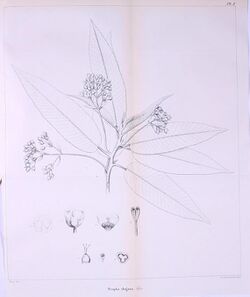Biology:Saurauia elegans
| Saurauia elegans | |
|---|---|

| |
| Botanical illustration of Saurauia elegans (using the basionym "Scapha elegans") | |
| Scientific classification | |
| Kingdom: | Plantae |
| Clade: | Tracheophytes |
| Clade: | Angiosperms |
| Clade: | Eudicots |
| Clade: | Asterids |
| Order: | Ericales |
| Family: | Actinidiaceae |
| Genus: | Saurauia |
| Species: | S. elegans
|
| Binomial name | |
| Saurauia elegans (Choisy) Fern.-Vill.
| |
| Synonyms | |
|
Saurauia rugosa Turcz. | |
Saurauia elegans is a species of plant in the family Actinidiaceae. It is native to The Philippines .[2] In The Philippines it is commonly called uyok and is used as a traditional medicine for lung ailments and also to decorate food dishes.[3]
Description
It is a tree reaching 20 feet in height.[4] Its twigs are covered in rough hairs. Its leaves are 10.2 – 12.7 centimeters long, 2.7-3.4 cm wide at their base and come to a point at their tip. Its petioles are 0.5 inches long. Its flowers are axillary. Its oval-shaped sepals are 3.4 millimeters long. Its corolla are 6.8 millimeters long. It has numerous stamens and 3 styles. Its seeds are wrinkled and angular.[5][6]
Reproductive biology
The pollen of S. elegans is shed as permanent tetrads.[7]
References
- ↑ Energy Development Corporation (EDC) (2022). "Saurauia elegans". IUCN Red List of Threatened Species 2022: e.T203176899A203235056. https://www.iucnredlist.org/species/203176899/203235056. Retrieved 18 December 2022.
- ↑ "Saurauia elegans (Choisy) Fern.-Vill.". The Trustees of the Royal Botanic Gardens, Kew. n.d.. https://powo.science.kew.org/taxon/urn:lsid:ipni.org:names:317247-1.
- ↑ Chua-Barcelo, Racquel Tan (2014). "Ethno–botanical survey of edible wild fruits in Benguet, Cordillera administrative region, the Philippines". Asian Pacific Journal of Tropical Biomedicine 4 (Suppl 1): S525–S538. doi:10.12980/APJTB.4.201414B36. ISSN 2221-1691. PMID 25183144.
- ↑ Christensen, Carl (1933). "Report of Mount Pinatubo Ferns". Leaflets of Philippine Botany 9: 3139–3172. https://www.biodiversitylibrary.org/item/6768.
- ↑ Choisy, J.-D. (1855). "Mémoire sur les Familles des Ternstroemiacées et Camelliacées" (in French, Latin). Mémoires de la Société de physique et d'histoire naturelle de Genève 14 (1–2): 91–184. https://www.biodiversitylibrary.org/item/41153.
- ↑ Fernández-Villar, Celestino (1880–1883). "Ordines Plantarum Dicotyledonearum" (in Spanish, Latin). Novissima Appendix ad Floram Philippinarum. Manila: Establecimiento tipográfico de Plana y C.ª. p. 19. http://bibdigital.rjb.csic.es/ing/Libro.php?Libro=12&Pagina=226.
- ↑ Dickison, William C.; Nowicke, Joan W.; Skvarla, John J. (1982). "Pollen Morphology of the Dilleniaceae and Actinidiaceae". American Journal of Botany 69 (7): 1055. doi:10.1002/j.1537-2197.1982.tb13351.x. ISSN 0002-9122.
Wikidata ☰ Q17251621 entry
 |


